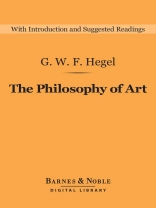This edition includes a modern introduction and a list of suggested further reading.
We have reached the end of art, states Georg Wilhelm Friedrich Hegel in
The Philosophy of Art. Hegel charts the progression of art in order to show how it reached its full and final development. But that does not mean that art is dead to us-far from it. Hegel argues for the significance of the philosophy of art, which for him ranks higher than the study of nature in terms of aiding our understanding of reality. Accompanying Hegel’s overview of his science of aesthetics are a laudatory introduction by the prominent nineteenth-century scholar and translator W. Hastie and an extensive elaboration of Hegel’s ideas by his student C. L. Michelet.
Despre autor
Georg Wilhelm Friedrich Hegel, the son of an official in the government of Württemberg, was born in Stuttgart on August 27, 1770. At seminary in Tübingen where he met German poet Hölderlin and Friedrich Schelling, who would have a profound influence on Hegel’s philosophy. He published his first major work, the
Phenomenology of Spirit, in 1807. On November 14, 1831, Hegel died of cholera in Berlin, a year after being elected rector of the University of Berlin and four months after having been decorated by Friedrich Wilhelm III of Prussia.












